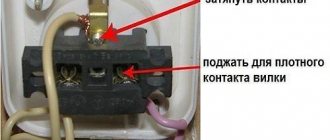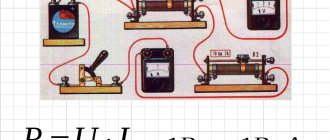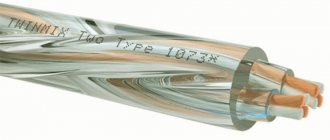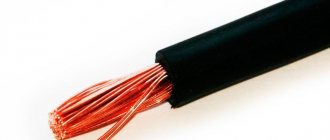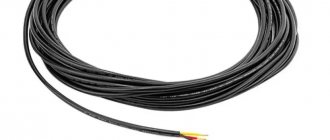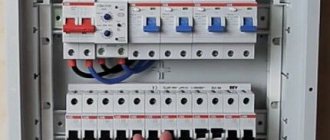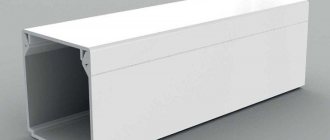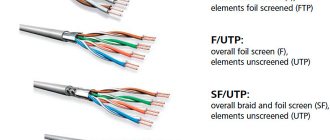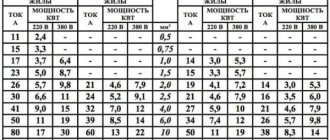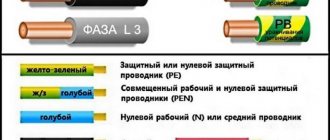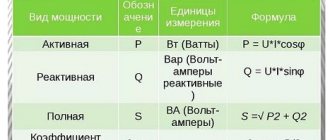Laying electrical wiring is one of the most important stages of home renovation. If you select the wrong current-carrying cable, the wiring may overheat and melt, and in some cases lead to a fire. We will tell you about the most popular types of cables used for wiring and explain how to choose the right wire cross-section. In this article, we will consider exclusively wire with copper conductors, since aluminum is falling out of popularity due to its low electrical conductivity compared to copper.
Difference between cable and wire
The question, by the way, is not simple. In particular, in accordance with SN, from the times of the USSR to the present day, work with cables is more expensive than with wires. However, there was no very clear classification in this regard, either in past times or today. Different sources provide a variety of perspectives. In practice, the characteristic “cable” or “wire” is assigned by GOST/TU for the production of a specific brand. In particular, the GDP brand cable from Odeskabel OJSC differs from the PVS brand wire only in the configuration of the sheath: the GDP cable is flat, and the PVS wire is round. And in no reference book about cables is the shape of the cable/wire sheath indicated as an insignificant factor. Therefore, you need to look at the certificate - it will certainly be stated there: this is a cable or wire.
Conclusions and useful video on the topic
This video provides detailed information on the selection of products for organizing electrical wiring in residential premises:
Despite the wide variety of products, it is quite easy to select the necessary material for laying electrical communications. You need to carefully read the markings, tags and product certificates, pay attention to the technical characteristics and quality of the cable .
Share with readers your experience of wiring in an apartment, tell us what cable you used. Please leave comments on the article and ask questions that interest you. The feedback form is located below.
Calculation of cable cross-section
There are reference plates indicating what cross-section of aluminum/copper conductor is needed for the assigned load. However, most electricians use a simple formula (consider a load of 8 kW): a copper cable cross-section of 1 mm2 can pass through 10A or 2.2 kW (power = 10A x 220V).
Therefore, a load of 8 kW in A will be equal to 36 A (load = 8 kW / 220V), and for a similar amount of current a cable with a cross-section of 4 mm2 .
This calculation is more or less suitable for cables with a cross-section of no more than 6 mm2. For large cross-sections, tables of “Permissible current loads” are needed.
With an equal load, the cross-section of the aluminum cable should be almost 30% larger than that of copper. The cable cross-section is the cross-sectional area of the core that conducts current.
The cross-section of a round current-carrying cable core is obtained according to the formula for the area of a circle S = π × r2, where the number π = 3.14, and r is the radius.
When there are a couple of wires in the core, then the cross-section of the core will be equal to the sum of the cross-sections of all the wires. The radius of the wire is measured with a caliper, and for very thin wires with a micrometer. How much cross-sectional margin is required? The reserve will undoubtedly not be superfluous. However, you need to know the limit.
For example, the limit of ordinary household socket-switches is 16A (3.2 kW = 16A x 220V) and connecting the socket using a 4 mm2 cable, with a throughput of 8 kW, is an inappropriate expenditure of finances.
And also, a cable with a cross-section of 4 mm2 will not fit into every socket.
Rational cross-sections in household electrical networks for copper: 1.5-2.5 mm2 for sockets and 0.75-1.5 mm2 for lighting.
We select the wire depending on the consumed load
The choice of wire according to the consumer's power is the choice of the cross-section of the electrical wiring.
Some equipment requires taking into account the reactive component of the electric current. Such devices include a refrigerator compressor, an electric motor for construction tools, and fluorescent lamps. In this case, the total power should be determined as follows: the active component of the power consumption should be divided by cosφ. The value of the last parameter can be found in the device passport.Formula for calculating current consumption: I = P/V, where P is power (the indicator can be found in the product data sheet), W; V – mains voltage (standard value 220 V).
When considering the choice of wires by current and load, you need to remember that for open wiring with a copper conductor, a current of 10 A/mm² is allowed, and if the wiring is closed, then 6 A/mm². For aluminum cables the values will be lower - 6 and 4 A/mm², respectively.
It is necessary to add up all the currents that flow through the wire, thereby calculating the total load. Next, focusing on the obtained value and using special tables, you need to select the desired section. Don’t forget to take a reserve of power – it’s possible that you will need to connect new devices to the network.
It is believed that for a lighting system with a current of 16 A it is better to use a wire with a cross-section of 1.5 mm². If it is necessary for the wiring to withstand a higher load, then the choice is made in favor of a 2.5 mm² cable. For powerful devices, stretch the cable 4 mm². The cross-section of the entrance to the building or apartment must be 1 level higher than the maximum internal load.
Which cable to choose: copper or aluminum?
Many “experts” will say with absolute certainty - copper. Why? For the consumer, copper, compared to aluminum, is advantageous in that sooner or later copper does not deteriorate so quickly, and this is very significant when replacing lamps, etc. Whether it is necessary to pay three times more for this is a decision for the consumer.
You only need to connect copper and aluminum cables using a terminal block so that the aluminum does not come into contact with the copper.
Because due to some physical phenomena at the point of contact between aluminum and copper, the current resistance increases after some time. As a result, the connection point heats up extremely intensely, the cable breaks, a short circuit occurs, and in extreme cases, a fire. By the way, the connection of any heterogeneous materials with different resistance leads to a similar result.
As a result, there is no need to sharpen the wiring with the first wire you come across by twisting it.
Depending on the area of use of the cable, the conductor is made from a variety of materials: first copper and aluminum, then nichrome, steel, etc. When you are not assured of the uniformity of the material of the cables being connected, use a terminal block.
Is it necessary to completely change the wiring?
The main reasons for a complete change in apartment wiring
If we are talking about laying electrical wiring in a newly built house, or in an apartment that was purchased in a “bare”, completely unfinished form, only with an input cable installed and an installed meter, then such a question is not even raised - everything has to be done “from scratch”.
But when carrying out major renovations in their properties, many owners are faced with the temptation - maybe they should leave it as it is? Moreover, if the functioning of the home electrical network has not yet been accompanied by any emergency situations, has not caused any complaints and has not given rise to any reason to take emergency measures?
The owners’ doubts are quite understandable: replacing wiring is a very large-scale and labor-intensive process. And it will be associated not only with electrical installation work, which in itself is not easy. There will be quite “dirty” and tedious operations for cutting channels (cuts) for laying cables, sockets for sockets, switches, and junction boxes. All this, of course, will then require high-quality finishing. In a word, it’s scary to take on!
The laying of new home wiring cables is always associated with large-scale general construction work, and then finishing work. Many are stopped by this prospect, but there is no other way...
So, what should motivate owners to make such a decision:
- If the question of general major housing repairs arises, then, presumably, the previous one was carried out quite a long time ago, sometimes even several decades ago. And it will be carried out again with a long-term perspective, which amounts to the same tens.
Wiring cannot be classified as a “perishable” material, however, it also has its own service life. Over time, the wire insulation loses its elasticity and begins to crack or even begin to crumble. And this can cause a short circuit, which is very close to a fire hazard. And metal does not last forever - it gradually “ages”, oxidizes, and becomes more fragile, which is a prerequisite for sudden breaks in the network in the most unexpected places.
Would you dare cover such old wiring with a new finish, in the hope that it will serve for another ten or two years? Or is it better not to take risks so as not to lose more?
In a word, in order to be guaranteed to protect yourself from troubles for many years to come, the wiring should be changed to a new one.
- The second aspect of the problem is the following. The saturation of modern life with electrical appliances, even for an average-income family, cannot be compared with what it was like just one and a half to two decades ago. And new technology requires connection points, and they must meet both the requirements of ease of use and safety rules. Cascades of tees and extensions are a direct path to line overload and a fire hazard. And cords getting tangled under your feet do not add to the comfort of living in an apartment.
With the advent of new household priors, there is a shortage of sockets.
But what is shown in the photograph is not a way out of the situation at all - it is both inconvenient and extremely dangerous! In addition, the old wiring was laid long ago without taking into account the increased power consumption. The purchase of new household appliances often requires the installation of dedicated power lines, since old wires simply may not be able to cope with the load.
Therefore, since a large-scale reconstruction of housing is ahead, it makes sense to redesign the electrical network, thinking through the optimal location of all its elements. And not only in such a way that it meets the current availability and power of electrical household appliances, but also with some reserve for the future.
There is one more reason that may be decisive for the decision to reconstruct the home electrical network. It deserves special mention.
Aluminum is out of the question!
In the era of mass housing construction, when five-story “Khrushchev” buildings, and then houses of later series, grew like mushrooms in cities, the installation of aluminum wiring was widespread practice. At one time, this was justified - it was much cheaper, and large loads were not expected. But if now the owner of an apartment or house sees that his wiring is made of aluminum wires, he should not have any doubts - only a complete replacement with copper!
First of all, this is a direct, non-negotiable requirement of current legislation in the field of construction and safety. If before 2001 the documents made a reservation about the permissibility of aluminum wiring, and then only for the already existing construction groundwork, now the requirement is categorical:
Article 15.3 is relevant to the edition of SP 31-110-2003 “Electrical installations of residential and public buildings. Rules for design and installation."
Internal electrical networks must be flame retardant and made with cables and wires with copper conductors in accordance with the requirements of 2.1 and 7.1 PUE, GOST 31565-2012, GOST R 50571.5.52-2011, SNiP 3.05.06-85, as well as electrical requirements and fire safety.
These requirements are not taken out of nowhere - they are determined by an analysis of experience in the use of both types of wiring and are based on the comparative characteristics of aluminum and copper as current conductors.
A comparison shows that in almost all respects (except, perhaps, cost), aluminum wiring is inferior to copper wiring.
Let's compare on several points:
A. Although aluminum is considered a good conductor with low resistance, it cannot compare with copper. This is most clearly seen if we use a conventional value accepted in electrical engineering, called electric current density. It shows how much current can pass through a unit cross-sectional area of a conductor (1 mm²) without causing dangerous heating, which can lead to melting of the insulation and a short circuit.
If we consider copper, then this figure reaches 10 amperes with open wiring, and 6 amperes with hidden wiring. For aluminum, these figures are much lower - 4 and 6 amperes, respectively. That is, under equal conditions, the cross-section of the aluminum wire should be at least one and a half times larger.
The above values should not be used as a basis for network design - they are provided as an example only. And for real operating conditions, of course, a certain reserve must also be included.
B. Both aluminum and copper are quite active elements from a chemical point of view. They easily react with oxygen contained in the air and quickly (aluminum - almost instantly) become covered with a layer of oxides. But aluminum oxide has much lower conductivity than copper oxides. That is, the resistance on aluminum contacts will always be greater than on copper ones. That is, such connections are more susceptible to heating under high load.
IN . Both metals have good ductility, which is important when installing wiring. But internal fatigue of the aluminum crystal lattice occurs much faster. In other words, such a wire breaks much more easily under mechanical stress. A simple experiment: try bending and unbending a copper and aluminum conductor several times in one place. The result is completely obvious.
By the way, this fragility of aluminum only increases over time - this is a feature of the reaction of its crystal lattice to gradual oxygen corrosion in combination with heating. And in the end, getting an unexpected break in the wiring when using aluminum is much higher than with copper.
D. Another negative feature of aluminum is the lack of stability of its forms. Under the influence of constant mechanical load, it simply begins, as electricians often say, to “float.” For example, over time, even a well-tightened screw terminal with an aluminum wire begins to heat up - the contact clearly weakens and requires regular tightening. The same applies to strands - sparking appears between the conductors, which leads to their strong heating. Even worse, if there is a small gap between the wires, these are already conditions for the occurrence of an electric arc with its temperatures of several thousand degrees, leading to melting of the metal and ignition of the insulation.
Melting of insulation, breaks on aluminum wires in places of twists or terminal connections - a very common phenomenon
You can immediately notice that twisted connections of aluminum and copper wires are completely unacceptable. Differences in chemical structure, electrical conductivity, and linear expansion when heated make such compounds extremely unreliable, short-lived and extremely dangerous. If circumstances force such a contact to be made (although this should be avoided in every possible way), then terminals of one type or another should be used, ensuring the transmission of current through a steel “intermediary” - a screw, busbar, spring, etc.
For such “antics” it would be necessary to deprive the “master” of the right to engage in electrical work for life
And to avoid the temptation to make such a connection, you should simply exclude aluminum from your home wiring.
So, we hope we have convinced the reader of the need to replace the old wiring and do it with copper. If anyone, for reasons of economy or simply not understanding the importance of the issue, nevertheless decides to use aluminum wires, then he may not read this publication further. All further presentation will be devoted exclusively to copper - as required by both the current rules and elementary prudence.
Which cable is optimal: flexible or rigid?
A rigid cable is usually a single-core cable, and a flexible cable is usually a multi-core cable. The greater the number of wires in the core and how thinner each wire is, the more elastic the cable.
Based on flexibility, the cable is divided into 7 classes: monocore is class 1, and class 7 is the most flexible.
As the flexibility class of the cable increases, its price increases. A rigid cable is used for inserting into walls and laying in the ground, and a flexible cable is used for connecting maneuverable devices or electrical appliances. From an operational point of view, it doesn’t matter which cable to choose - rigid or flexible. From an installation point of view, every electrician has his own wishes. By the way: the ends of the flexible cable, which are embedded in sockets (switches), must certainly be soldered or crimped using special ends. For a rigid cable, a similar procedure is not necessary. To connect lighting equipment, it is better to purchase a flexible cable, because lighting devices are often replaced, and a rigid cable is more likely to break when connecting new electrical equipment.
How to independently determine the quality of the cable?
Many manufacturers do not always comply with cable manufacturing standards. Their main “trick” is to underestimate the cross-section of the conductor. And sometimes significantly. Of course, it is difficult to examine the cross section at the point of purchase. In the store you can measure any wire with a caliper and a micrometer.
You can also come across cables with a reduced sheath thickness or with a sheath made of low-quality material, and this reduces the service life of the cable.
For inspection, it’s a good idea to have a piece of the “correct” cable with you as a standard. In stores you can come across a Chinese cable made of aluminum covered with copper (sold as copper with markings in Cyrillic).
It is easy to inspect such a cable: the cut of the current-carrying core on the cable gleams white - it is aluminum.
There are manufacturers who use low-quality copper or aluminum to reduce costs. Such cables have a much lower service life and conductivity than those required by GOST. It is possible to test the quality of the metal of a current-conducting core as follows:
- try bending and straightening the cable a couple of times. In factories, such a test is performed on a special bending mechanism under a certain bending radius. Of course, your number of bends will be less than those provided for in GOST. However, in any case, aluminum should withstand at least 7-8 bends, and copper - 30-40. After this, deformation of the insulation and wire breakage are possible. It is better to carry out the experiment at the end of the cable, so that you can simply cut it off later.
- a cable made of high quality copper/aluminum should bend and not spring;
- the copper/aluminum core on the stripped cable should have a bright (glare) color. When the vein is heterogeneous in color and there are hopeless spots, this indicates large impurities in the metal and its low quality.
Nevertheless, an amateur will not be able to determine the quality of the cable 100% on his own. In this case, there is only one recommendation - rely on the brand and purchase it in large, trusted stores.
Which wires are not suitable?
There are product options that are strictly prohibited from being used for laying electrical networks, even in the most extreme cases. These include the following types of products.
Product #1 - PVS wire
Copper connection element having a PVC sheath and insulation. It has a stranded design with 2-5 conductors with a cross-section of 0.75-10 sq. mm.
The wire, designed for a voltage rating of 0.38 kW, can be used to connect household electrical appliances to the power grid and for making extension cords.
PVA is not suitable for laying wiring for the following reasons:
- It has a multi-wire core structure, so it requires tinning and soldering to connect the ends, which requires a lot of time and a lot of experience.
- The product creates a fire hazard: the wire strands cause the cable to heat up more, causing the insulation to wear out faster, which can lead to a short circuit.
- PVA cannot be laid in a bundle, whereas almost all cable models are suitable for this. Due to the fact that the wiring lines must be at a certain distance from each other, you will have to make grooves in the wall for each of them.
Thus, even the low price of such wires cannot compensate for the high installation costs, and the quality of the installed electrical network will not be too high.
Product #2 - SHVVP, PVVP wires
Cords or cables having single or multi-wire copper cores can be used to connect household appliances and electrical equipment.
However, they are not suitable for fixed electrical communications because these products do not have non-combustible insulation.
Although a flat cord with polyvinyl chloride sheaths (SHVVP) is not recommended for laying electrical networks, it is quite suitable for organizing low-current lighting up to 24V, namely for laying wiring from a transformer to LEDs
In addition, the service life of SHVVP and VPPV is quite short, and the multi-core design requires processing of the ends and soldering during installation.
It is also worth mentioning PUNP (universal flat wire), which was banned for laying electrical networks in apartments back in 2007.
This outdated product has poor insulation and low power, making it unable to withstand modern loads
What kind of insulation and sheath should the cable have?
It is best when the insulation and sheath of the cable are double insulated. A single-insulated cable has a service life of up to 15 years, while a double-insulated cable usually lasts 2 times longer. Typically, “insulation” and “sheath” are 2 different materials. The insulation is the layer of dielectric material that goes immediately behind the conductive core, and the sheath is all the layers on top of the insulation. The sheath is intended to protect the cable from various mechanical influences. The cable may have a couple of layers of sheath made of different types of material. Certain types of shell that may be useful:
- Heat-resistant cables are designed for installation in rooms with high temperatures (saunas). Typically, the material used is fluoroplastic, with fiberglass on top. There are no special designations for such cables, i.e. if necessary, you need to seek help from reference books or catalogs, where the value of the “operating temperature” is indicated precisely;
- non-flammable, marked “ng” - indicates the ability to self-extinguish when the flame disappears, but cannot withstand high temperatures
- when the cable brand contains “FR” (fire resistant) and then E30, E90 or E120, then this cable can “function” in an open fire for 30, 90 or 120 minutes;
- cables with a polyethylene sheath can be pulled both in the soil and in an open way (for example, along the walls of houses);
- cables with insulation and sheath made of PVC (polyvinyl chloride) are used for pulling inside buildings (under plaster) or in cable ducts.
Safety of installation and connection
Most electrical fires and accidents are usually due to improper installation and poor connections. Therefore, the reliability of the wire connection must be taken with particular seriousness.
Connections are made in switchgear, connection and final installation products. Copper wires with a cross-sectional area of up to 6 mm² were traditionally connected by twisting followed by soldering with lead-tin solder (or special for a particular conductor). Modern technologies significantly simplify this procedure, ensuring reliability and quality of connections. Protective caps can be installed on top of the twist, inside of which there is a graphite lubricant that prevents oxidation of the contacts.
You can do without twisting, preferring spring terminals. Unlike other types of connections, spring terminals allow:
- Make electrical installations faster.
- They have guaranteed reliable contact, eliminating short circuits and heating at the connection point.
- Provide protection from contact with live parts.
The most famous cable brands
- wire PPV (copper), APPV (aluminum) in single insulation - for pulling inside walls;
- cable PVS (copper), GDP (copper) in double insulation - for pulling inside buildings;
- heat-resistant cables RKGM (copper) - up to 180°C, BPVL (tinned copper) - up to 250°C;
- cable VVG (copper), AVVG (aluminum) - for stretching along the walls of houses and in the ground;
- runway cable (copper) water-submersible - for pulling in water;
- TPP cable (copper) telephone pair - for pulling in the ground;
- TRP wire (copper) telephone distribution for subscriber communications (switching on the telephone)
- twisted pair cable UTP, FTP - for organizing computer networks, turning on intercoms, etc.;
- “Alarm” signal wire for connecting intercoms, security and fire alarms, etc.;
- coaxial cable RG-6 for connecting TVs, antennas, CCTV cameras.
Internet cable
The concept of “Internet cable” generalizes many types of cable products. A variety of information cables are used to broadcast information. If you mean connecting to the Internet, then you need to check with the operator which cable needs to be laid across the walls. In this case, it is necessary to find out both the brand of the cable and the manufacturer in order to accurately determine compatible cable products.
For example, for the Internet they use a regular television cable TM Finmark, a twisted pair cable or an existing subscriber cable (the so-called “noodles”) to which the telephone is connected.
Optical cables can be laid on dedicated Internet lines.
Computer cable
The term is also general.
As a rule, a twisted pair cable is used to connect PCs with each other and with the server, but other information cables can also be used.
The technology of twisting two wires into a pair has been used in telephony since the last century. Due to the correctly calculated twisting pitch and the quality of the material, a maximum information transfer speed was achieved than that of a standard paired telephone cable. There are quite a few types of twisted pair cables, depending on the number of cores, the diameter of each core, installation locations, etc. Depending on the data transfer speed, twisted pair cables are divided into groups:
- 3rd category (standard telephone cable),
- 5th category (office networks),
- 6th category (new generation cable for changing category 5).
“Twisted pair”, which has gained the greatest popularity in our time, is a category 5 cable made of 8 pairs of twisted cores, the core diameter is a minimum of 0.45 mm and a maximum of 0.51 mm.
Which is better VVGng Ls or NYM
Now that we have decided on the last cable index (LS), all that remains is to choose whether it will be the NYM or VVG option. Here, from a technical point of view and compliance with current GOSTs, there is not much difference.
Choose any type - VVGngLS or NYM, but again not a simple one, namely NYMng LS.
The NYM cable is made according to the German standard (at least it should). Previously, this cable was positioned as a desirable replacement for VVG, but with improved characteristics.
It has a round shape, which is very convenient for installation, installation and sealing of seals in distribution cabinets.
True, for high-quality cutting of such products you will need a special insulation stripper.
But buying a round VVG is not always quick. Inside NYM, between isolated veins, there is a chalk-filled porous mass.
In fact, this means almost triple insulation. However, the outer shell has a significant drawback.
It is not resistant to ultraviolet radiation, so this cable cannot be laid outside the house along the walls.
Another drawback is that it is almost impossible to find special NYMng-LS brands on the open market. The VVGngLS cable is much more accessible, cheaper and easier to manufacture.
Here's a comparison of the prices of both options in online stores. Feel what is called the difference.
Please note that we are talking only about the GOST cable, and not about those “counterfeits” manufactured according to the technical conditions invented by the plant itself. Read in detail about all the pitfalls and troubles that you will certainly encounter when working not only with cables, but also with SIP wires manufactured according to specifications in a separate article.
By the way, the cable on sale is not NYM, but NUM or NUM. This brand is also produced by cable factories, but without German VDE quality certificates. They purposefully change the name so as not to have problems with the license.
When purchasing such products, no one guarantees you how long they will last and whether they will meet all the declared characteristics in comparison with the originals. Here you act at your own peril and risk.
Some electricians claim that in order to comply with all GOSTs when installing electrical wiring in a house, the usual “correct” NYM will do. After all, its composition is practically no different from VVGng-LS.
This is not entirely true. Take a look at the technical specifications table below for a simple NYM.
It shows that there are simply no special functions that would allow it to be used in residential apartments without any problems!
That's why craftsmen, developers and electricians use VVNG LS everywhere. This is the most optimal option in terms of price and quality, fully meeting the requirements of GOST.
